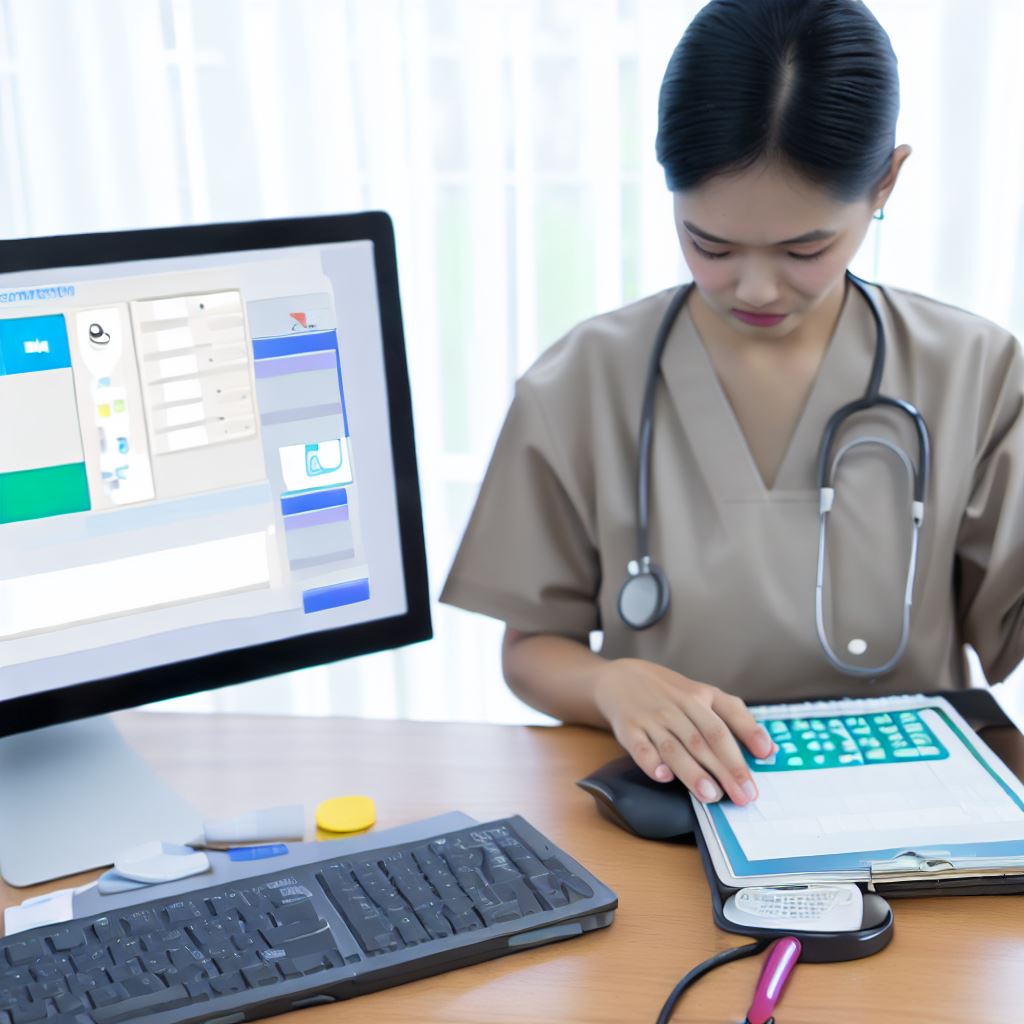Introduction
Medical coding plays a crucial role in the healthcare industry by translating medical procedures, diagnoses, and services into standardized codes.
These codes are used for various purposes, such as billing, insurance claims, reimbursement, and data analysis.
In this blog post, we will focus on the importance of medical coding and discuss some essential tools and software used in the field.
Medical coding is a complex process that requires accuracy, attention to detail, and knowledge of various coding systems.
The blog post will provide an overview of the necessary tools and software that medical coders rely on to efficiently perform their duties.
These tools range from coding books and encoders to electronic health record (EHR) systems and coding software.
By using these tools, medical coders can streamline the coding process, reduce errors, and ensure compliance with coding guidelines.
We will explore the features, benefits, and limitations of each tool, helping readers understand their relevance in the medical coding profession.
Furthermore, the blog post will highlight the role of technology advancements in medical coding and how these tools and software have evolved over time.
We will also discuss the importance of staying updated with the latest coding guidelines and regulations.
Therefore, this blog post aims to emphasize the significance of medical coding in the healthcare industry and shed light on the essential tools and software that facilitate efficient and accurate coding practices.
By utilizing these resources, medical coders can play a vital role in ensuring proper reimbursement and maintaining comprehensive healthcare data.
Medical Coding Basics
Medical coding is the process of assigning standardized codes to medical procedures, diagnoses, and treatments.
Its purpose is to ensure accurate reporting, billing, and reimbursement in healthcare.
There are various coding systems used in medical coding, including ICD-10-CM (International Classification of Diseases, 10th Revision, Clinical Modification), CPT (Current Procedural Terminology), and HCPCS (Healthcare Common Procedure Coding System).
Tech Consulting Tailored to Your Coding Journey
Get expert guidance in coding with a personalized consultation. Receive unique, actionable insights delivered in 1-3 business days.
Get StartedICD-10-CM is a coding system used to classify and code diagnoses.
It provides specific codes for various illnesses, injuries, and conditions, allowing healthcare professionals to accurately document a patient’s medical history.
CPT codes, on the other hand, are used to describe medical procedures and services provided to patients.
These codes help with billing and reimbursement, as they provide a standardized way of categorizing and documenting healthcare services.
HCPCS codes are similar to CPT codes and are used for Medicare billing.
They cover supplies, equipment, and services not included in the CPT system.
HCPCS codes are essential for accurate billing and reimbursement in Medicare and Medicaid.
Role of medical coders in translating patient information
Medical coders play a crucial role in the healthcare industry, translating patient information into standardized codes.
Their responsibilities encompass reviewing medical records, including doctors’ notes, lab results, and relevant documentation.
By analyzing this information, they accurately assign codes that represent the patient’s condition and services rendered.
The importance of accurate medical coding extends to medical billing, insurance claims, and healthcare statistics.
Here are key points about medical coding:
- Accurate Reimbursement: Proper coding ensures healthcare providers receive correct reimbursement for their services and aids insurance companies in claims processing.
- Quality Assessment: Accurate coding contributes to quality assessment and research studies within the healthcare sector.
- Essential Tools: Medical coders rely on various tools and software for efficient coding, such as encoding software, computer-assisted coding (CAC) software, and electronic health record (EHR) systems.
- Encoding Software: This tool offers a comprehensive code database for quick and accurate code selection.
- Computer-Assisted Coding (CAC): CAC software suggests potential codes based on documented information, which coders can review and verify.
- EHR Systems: EHR systems integrate patient information, coding, and billing, reducing manual entry and minimizing errors.
- Continual Education: To stay updated with coding guidelines and regulations, medical coders engage in ongoing education through certification programs and professional associations.
In summary, medical coding is indispensable in healthcare, facilitating accurate documentation, billing, reimbursement, and research.
Coders utilize coding systems and tools to efficiently translate patient information into standardized codes, contributing to the overall efficiency and precision of healthcare coding and billing processes.
Build Your Vision, Perfectly Tailored
Get a custom-built website or application that matches your vision and needs. Stand out from the crowd with a solution designed just for you—professional, scalable, and seamless.
Get StartedRead: Transitioning from Scratch to Python: A Seamless Journey.
Electronic Health Record (EHR) Systems
In the digital age, electronic health record (EHR) systems have become an essential tool for medical coding.
These software platforms provide a range of benefits, features, and functionalities that help streamline the coding process, improving accuracy and efficiency.
Explanation of EHR systems and their benefits
- EHR systems are electronic platforms that store and manage patients’ health information digitally.
- They offer healthcare providers quick access to comprehensive and up-to-date patient records.
- With EHR systems, medical coders can easily access relevant patient data, such as diagnostic tests, medications, and procedures.
- These systems help coders ensure accurate and complete code assignments by providing a holistic view of a patient’s medical history.
- EHR systems also enhance communication and collaboration among healthcare professionals, leading to better coding outcomes.
Features and functionalities relevant to medical coding
- EHR systems include features that support medical coding, such as built-in coding dictionaries and reference materials.
- The software provides coding prompts and suggestions, helping coders select the most appropriate codes for diagnoses, procedures, and treatments.
- EHR systems automate certain coding tasks, reducing manual effort and minimizing the risk of errors.
- These platforms allow medical coders to document coding information directly within the system, eliminating the need for separate coding documents.
- EHR systems often have auditing tools that can flag potential coding gaps or discrepancies, ensuring compliance and accuracy.
Integration of coding tools within EHR systems
To further assist in the coding process, some EHR systems integrate coding tools directly within their platforms.
- These coding tools may include encoders, which help coders assign accurate codes by analyzing medical documentation.
- Encoders provide real-time feedback and flag potential errors or inconsistencies in coding decisions.
- They also offer coding guidelines and regulatory information to ensure compliance with coding standards.
- Integration of coding tools within EHR systems promotes efficiency by reducing the need to switch between multiple applications.
- Furthermore, seamless integration improves data accuracy by eliminating the risks associated with manual data transfer.
In essence, electronic health record (EHR) systems play a crucial role in the field of medical coding.
They offer numerous benefits, provide relevant features, and support coding through integration with coding tools.
By leveraging EHR systems and their functionalities, medical coders can efficiently and accurately assign codes, resulting in improved patient care and healthcare outcomes.
Read: Using Scratch in the Classroom: A Teacher’s Perspective
Coding Manuals and References
Introduction to coding manuals and their significance
- Coding manuals act as essential tools for medical coders, providing guidance and reference materials.
- These manuals contain detailed instructions and codes required for accurate medical coding.
- They are crucial in translating medical documentation into standardized codes for billing and statistical purposes.
- Medical coders rely on coding manuals to ensure compliance with industry guidelines and regulations.
Key coding manuals (ICD-10-CM, CPT, HCPCS)
- The International Classification of Diseases, Tenth Revision, Clinical Modification (ICD-10-CM) manual is widely used for diagnostic coding.
- ICD-10-CM contains a comprehensive list of codes for various diseases, injuries, and medical conditions.
- The Current Procedural Terminology (CPT) manual is essential for procedural and service code assignment.
- CPT codes cover a wide range of medical services, including surgeries, consultations, and laboratory tests.
- The Healthcare Common Procedure Coding System (HCPCS) manual focuses on procedures not covered by CPT codes.
- HCPCS codes include durable medical equipment, supplies, drugs, and other healthcare services.
Utilizing coding guidelines and conventions effectively
- Coding guidelines accompany coding manuals, providing instructions for code assignment and sequencing.
- Understanding and adhering to these guidelines is crucial for accurate and compliant coding.
- Guidelines help coders determine the appropriate code for each diagnosis or procedure.
- They also provide specific instructions for coding different scenarios, such as complications or combination codes.
- Coders must familiarize themselves with the conventions used in coding manuals, such as instructional notes and symbols.
- Following these conventions ensures proper code interpretation and avoids coding errors.
- Proper utilization of coding guidelines and conventions enhances coding accuracy and reduces claim denials or rejections.
- Regular updates to coding manuals and guidelines are essential, and coders must stay informed of these changes.
In fact, coding manuals and references play a crucial role in medical coding practices.
They provide the necessary codes, guidelines, and conventions for accurate and compliant coding.
Medical coders must utilize these tools effectively to ensure proper code assignment and avoid errors that could impact billing and reimbursement.
Staying updated with coding manual changes is also essential to maintain proficiency in medical coding.
By utilizing coding manuals and references correctly, medical coders contribute to the efficiency and accuracy of healthcare coding processes.
Optimize Your Profile, Get Noticed
Make your resume and LinkedIn stand out to employers with a profile that highlights your technical skills and project experience. Elevate your career with a polished and professional presence.
Get NoticedRead: 10 Cool Projects You Can Build in Scratch Today!
Computer-Assisted Coding (CAC) Tools
Computer-Assisted Coding (CAC) systems are essential tools used in medical coding that offer numerous advantages and significantly improve accuracy and efficiency.
This blog section explores CAC systems and their role in the medical coding process.
Explanation of CAC Systems and Their Advantages
- CAC systems are software programs used to automatically generate medical codes based on clinical documentation.
- These tools analyze electronic health records (EHRs) and identify relevant diagnoses, procedures, and relevant information for coding.
- One of the advantages of CAC tools is the reduction in coding errors and inconsistencies.
- By automating the coding process, these tools minimize the risk of human error and improve coding accuracy.
- CAC systems also help coders save time by providing them with suggestions and recommendations.
- These suggestions ensure that coders select the appropriate codes, resulting in more accurate claims submissions.
- Furthermore, CAC tools can improve compliance with coding guidelines and regulations by providing real-time alerts.
- These alerts notify coders about potential coding conflicts or missing documentation, ensuring compliance with industry standards.
Use of Natural Language Processing (NLP) in CAC Tools
- Natural Language Processing (NLP) is a key component of CAC systems that enables them to understand and interpret medical language.
- With NLP, CAC tools can analyze and extract relevant clinical concepts from unstructured clinical notes or narratives.
- This ability to process unstructured data helps improve coding accuracy and capture additional details that may have been overlooked.
- NLP also allows CAC tools to identify synonyms, abbreviations, and acronyms commonly used in medical documentation.
- By recognizing these variations, coders can ensure consistency and accuracy in code assignment.
Enhanced Coding Accuracy and Efficiency
- Utilizing CAC tools significantly enhances coding accuracy, resulting in more precise and reliable medical codes.
- Automated code generation reduces the risk of coding errors caused by manual coding processes.
- Improved accuracy leads to proper reimbursement, reduced claim denials, and increased revenue for healthcare organizations.
- In addition to accuracy, CAC tools also boost coding efficiency by saving time and streamlining the coding workflow.
- With automated suggestions and alerts, coders can code faster and focus on more complex coding scenarios.
- CAC systems also facilitate collaboration between coders and clinicians, allowing for quicker code validation and clarification.
- Furthermore, coders can easily search for specific diagnosis codes and access coding references, reducing research time.
- Overall, CAC tools improve productivity, allowing coders to handle larger volumes of coding tasks with ease.
In review, Computer-Assisted Coding (CAC) tools are important assets in medical coding due to their ability to enhance coding accuracy and efficiency.
These tools utilize Natural Language Processing (NLP) to interpret medical language and provide suggestions and alerts to coders.
By automating the coding process, CAC tools minimize errors, improve compliance, and save time.
The incorporation of CAC systems in coding workflows can yield significant benefits for healthcare organizations, ensuring accurate claims submissions and optimized revenue generation.
Read: The Power of Visual Coding: Exploring Scratch Features

Encoder Software
Encoder software plays a crucial role in medical coding, offering automated code determination and validation.
One of the significant benefits of encoder software is its ability to automate code determination.
It uses algorithms and database lookups to match the diagnosis and procedures to the appropriate codes.
This automated process saves a significant amount of time and effort for medical coders.
Encoder software also ensures code validation by cross-checking the codes generated with the documentation provided by healthcare professionals.
This validation step ensures that the codes accurately reflect the patient’s diagnoses and treatments.
Linking codes to documentation for better accuracy
By linking codes to documentation, encoder software improves the accuracy of medical coding.
It helps coders easily access relevant information, such as medical records and reports, to ensure accurate code selection.
This linkage ensures that codes align with the specific documentation, reducing the risk of coding errors.
Another advantage of encoder software is its ability to provide real-time code updates.
As medical coding guidelines and regulations change, encoder software can easily update its code library to ensure compliance with the latest standards.
The software also offers quick code search capabilities, allowing coders to find specific codes by entering keywords or diagnoses.
This feature enhances efficiency and accuracy in the coding process.
Encoder software often integrates with electronic health record (EHR) systems, allowing seamless integration of coding and patient data.
This integration streamlines the coding workflow and ensures accurate documentation of procedures and diagnoses.
Additionally, encoder software provides built-in checks for coding errors, such as mismatched codes or incomplete documentation.
These checks help identify and correct errors before submitting claims, reducing the risk of denials or audits.
Due to the complex nature of medical coding, encoder software offers coding hints and tips to assist coders in accurate code selection.
These suggestions enhance coder productivity and ensure adherence to coding guidelines.
Furthermore, encoder software helps healthcare organizations track coding productivity and monitor coding patterns.
It provides detailed reports and analytics on coding accuracy, productivity, and coding trends, enabling organizations to identify areas for improvement.
In short, encoder software plays a vital role in medical coding by automating code determination, validating codes, linking codes to documentation, and providing real-time updates.
Its integration with EHR systems, quick code search capabilities, error checks, and coding hints further enhance coding accuracy and efficiency.
Audit and Compliance Software
When it comes to medical coding, audit and compliance play a vital role in ensuring accurate and error-free coding processes.
A crucial tool in this area is audit and compliance software, which helps healthcare organizations maintain adherence to coding rules and regulations.
Let’s delve deeper into the importance of this software and explore its key features.
Importance of Audit and Compliance in Medical Coding
Audit and compliance are essential components of medical coding that ensure the integrity and accuracy of patient data.
These processes help prevent fraud, identify coding errors, and maintain billing compliance within the healthcare industry.
By using audit and compliance software, organizations can proactively monitor and evaluate their coding practices to minimize risks and ensure ethical coding practices.
Features of Auditing Software
Audit and compliance software are essential tools in medical coding, offering various features and benefits:
- Claims Validation: These tools validate claims in real time, ensuring adherence to coding standards.
- Error Detection: They identify potential errors or inaccuracies, preventing costly denials and audits.
- Documentation Review: Audit software assesses the quality and completeness of medical documentation.
- Coding Guidelines Adherence: It ensures compliance with coding regulations from authorities like AMA and CMS.
- Real-time Monitoring: These tools track coding patterns and generate reports for timely issue resolution.
- Reporting and Analytics: Comprehensive reports help identify trends and optimize coding processes.
- Integration with EHR Systems: Seamless integration with EHR systems streamlines coding workflows.
Investing in reliable audit and compliance software promotes accurate, compliant, and ethical coding practices, benefiting healthcare providers and patients alike.
Online Resources for Medical Coders
When it comes to medical coding, staying updated on coding changes, continuously learning and connecting with others in the coding community are essential.
Fortunately, there are numerous online resources available to medical coders that can assist in these areas:
Websites, forums, and blogs for staying updated on coding changes
- AAPC (American Academy of Professional Coders): AAPC’s official website provides the latest coding news, updates, and resources, including coding books and forums for discussions.
- Centers for Medicare and Medicaid Services (CMS): CMS’s website offers official coding guidelines, manuals, and updates related to Medicare coding and billing practices.
- AMA (American Medical Association): The AMA website contains valuable information on Current Procedural Terminology (CPT) codes, including coding guidelines and updates.
- Journal of AHIMA (American Health Information Management Association): AHIMA’s journal publishes articles and research papers regarding coding, compliance, and industry trends.
Online training and educational platforms available
- AHIMA’s Virtual Lab: This virtual lab offers medical coders a hands-on learning experience with real-world coding scenarios and exercises.
- University-based online courses: Several universities offer online medical coding programs and courses that provide comprehensive training and education.
- LinkedIn Learning: LinkedIn Learning offers a variety of coding courses, including both beginner and advanced levels, taught by industry experts.
- YouTube tutorials: Many coding professionals and organizations share educational videos on YouTube, covering various coding topics and concepts.
Networking opportunities within the coding community
- Coding forums: Online coding forums, such as AAPC’s discussion boards, allow coders to ask questions, seek advice, and share experiences with fellow professionals.
- LinkedIn groups: Joining relevant LinkedIn groups dedicated to medical coding provides opportunities to connect with professionals, share knowledge, and explore job opportunities.
- Local coding chapters and associations: Many cities have local coding chapters and associations that regularly organize events and meetings for networking purposes.
- Medical coding conferences and webinars: Participating in conferences and webinars allows coders to connect with industry experts, learn about the latest advancements, and network with peers.
Having these online resources at your disposal can greatly benefit medical coders by keeping them updated, helping them expand their knowledge, and providing avenues for networking and professional growth.
Remember to tap into these resources regularly to stay at the forefront of the ever-evolving world of medical coding!
Mobile Apps for Medical Coders
Mobile apps have become an integral part of our daily lives, offering convenience and efficiency in various tasks.
Medical coders, who play a crucial role in the healthcare industry, can also benefit greatly from the use of mobile apps.
These apps are designed specifically for medical coders, providing them with essential tools and resources on-the-go.
In this section, we will explore the various mobile apps available for medical coders, their features, and how they can be used effectively.
Overview of Mobile Apps for Medical Coders
Mobile apps for medical coders are specifically designed to assist professionals in accurately assigning codes to medical diagnoses, procedures, and services.
These apps provide a seamless and portable experience, allowing coders to access coding references and tools anytime, anywhere.
They offer a range of features and functionalities that make the coding process faster and more efficient.
Features and Functionality of Coding Apps
- Code Search: These apps provide a comprehensive and up-to-date database of medical codes, including ICD-10, CPT, and HCPCS codes.
Coders can easily search for specific codes, eliminating the need for extensive manual searching. - Code Descriptions: Mobile coding apps provide detailed code descriptions, helping coders understand the context and meaning behind each code.
This ensures accurate code assignment and reduces the chances of coding errors. - Cross-Referencing: Many coding apps offer cross-referencing functionality, allowing coders to compare multiple codes and select the most appropriate one for each case.
This improves accuracy and ensures compliance with coding guidelines. - Updated Code Sets: Mobile apps for medical coders are regularly updated with the latest code sets, ensuring that coders have access to the most current information.
This is crucial in an industry where codes and guidelines are constantly changing. - Note Taking and Annotation: Some coding apps allow coders to take notes and annotate specific codes.
This feature is particularly useful for coders who want to add additional information or reminders for future reference.
Accessing Coding References and Tools on The Go
Mobile coding apps provide coders with the flexibility to access coding references and tools from anywhere at any time.
Whether working in a hospital, clinic, or while traveling, coders can quickly search for codes, verify documentation requirements, and ensure accurate code assignment without the need for bulky reference books or manual searches.
The convenience of mobile apps also enables coders to work more efficiently, resulting in increased productivity and faster turnaround times.
They can easily verify codes, check coding guidelines, and resolve coding-related queries without interrupting their workflow.
In addition to code search functionalities, some coding apps offer additional resources such as updated code sets, coding guidelines, medical dictionaries, and coding-related news and updates.
These resources further enhance the coding process and keep coders well-informed about industry changes and best practices.
Mobile apps for medical coders have revolutionized the way professionals work in the healthcare industry.
These apps offer a range of features and functionalities that simplify the coding process, improve accuracy, and increase productivity.
They provide coders with instant access to coding references and tools, eliminating the need for bulky reference books and manual searches.
By utilizing these mobile apps, medical coders can work efficiently on-the-go and ensure accurate code assignment in a fast-paced industry.
Conclusion
To summarize, we have covered the essential tools and software for medical coding in this blog section.
These tools include coding books, encoders, and electronic health record systems.
Utilizing appropriate tools is crucial as they enhance coding accuracy and efficiency.
With the help of these tools, medical coders can ensure correct coding, reduce errors, and improve productivity in their daily practice.
We encourage all medical coders to explore and adopt these tools in their coding practice.
By doing so, they can stay up-to-date with the latest coding guidelines and ensure optimal coding outcomes.
So, don’t hesitate to leverage these essential tools and software to streamline your medical coding process and enhance your coding skills.




